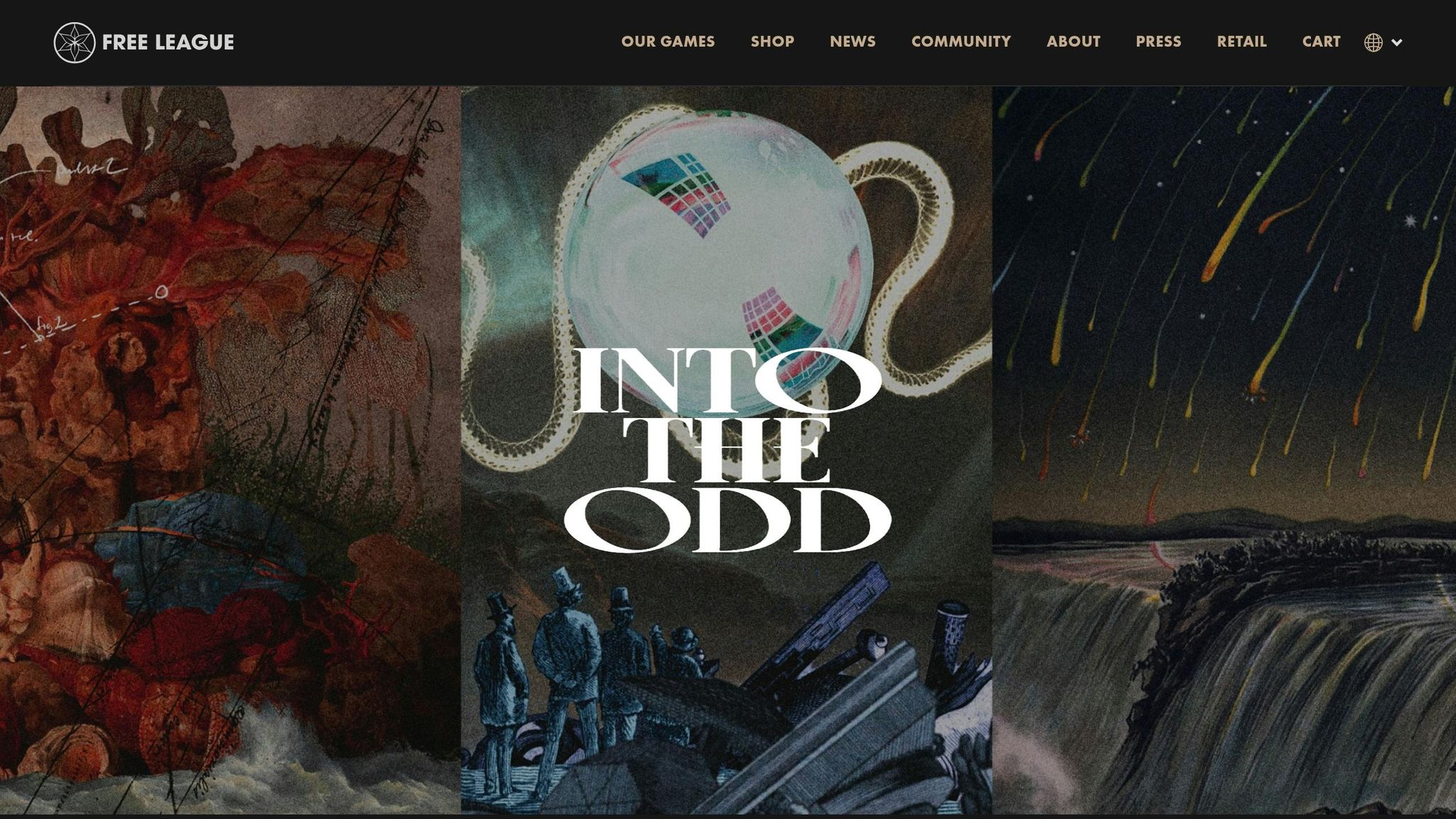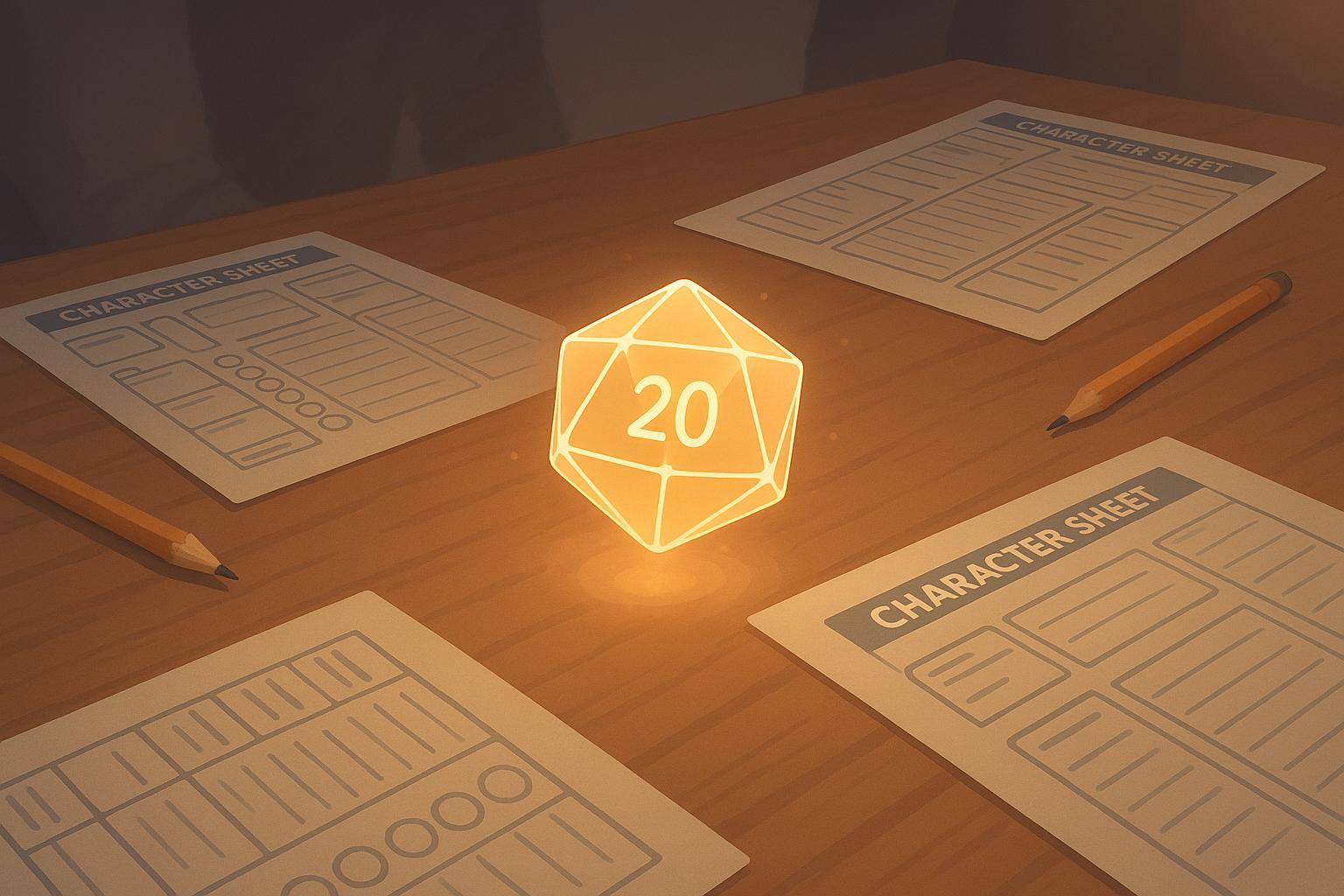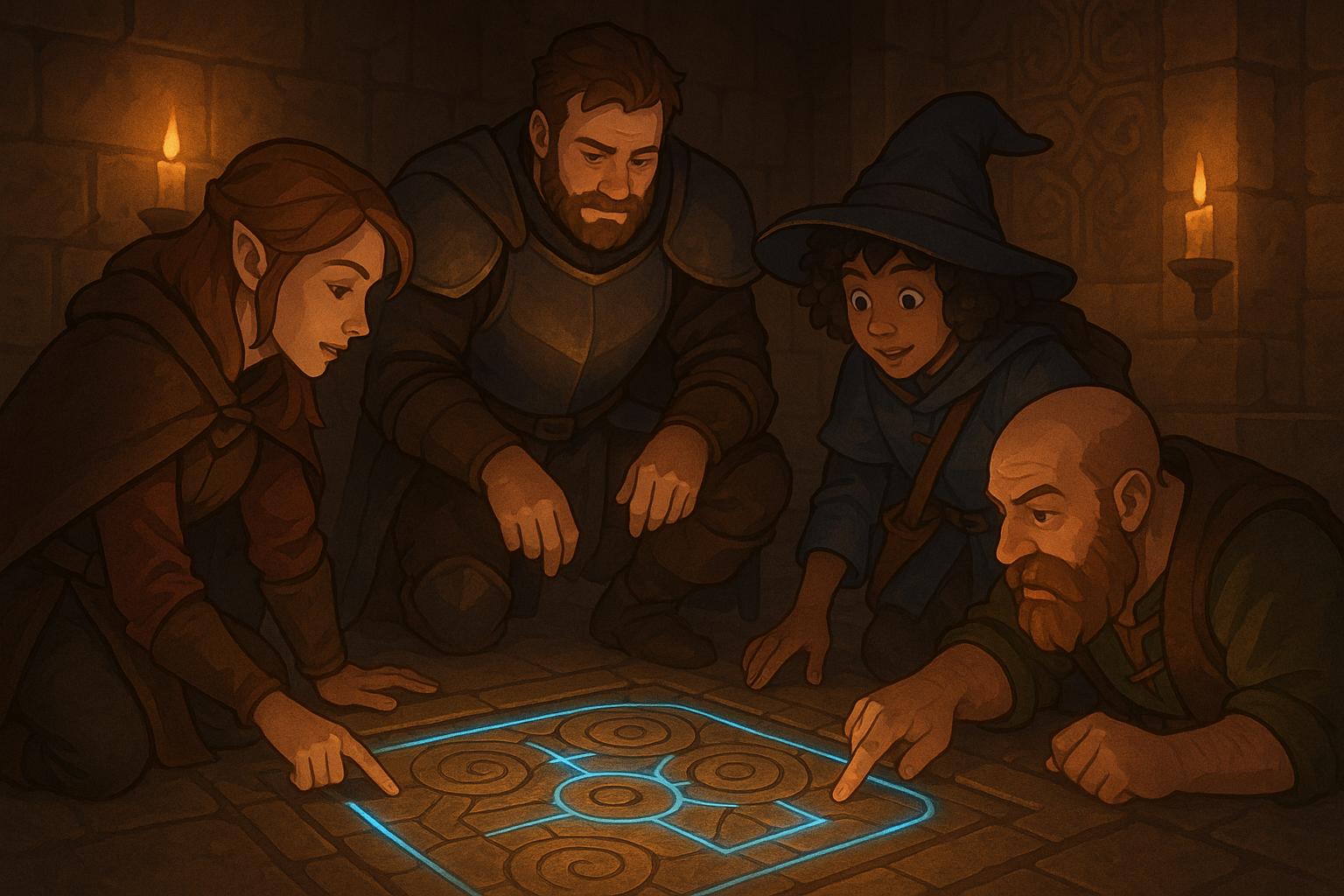Looking for a streamlined tabletop RPG that puts storytelling first? Games like Into the Odd and Cairn simplify mechanics to focus on creativity, exploration, and emergent narratives. Here's a quick breakdown:
- Into the Odd: Features a fast-paced industrial fantasy setting with three core stats (Strength, Dexterity, Willpower) and quick, high-stakes combat where every attack lands.
- Cairn: Adapts these mechanics for dark fantasy adventures, offering a 30-second character creation process and survival-focused gameplay.
Quick Comparison
| Feature | Into the Odd | Cairn |
|---|---|---|
| Core Stats | 3 stats (STR, DEX, WIL) | Same system |
| Setting Focus | Industrial-age exploration | Dark fantasy wilderness |
| Combat Style | Fast, lethal, and direct | Tactical with survival elements |
| Character Growth | Loot-driven and survival-based | Through experiences and treasures |
| GM Role | Flexible, relies on improvisation | Clearer guidance for structured play |
Both games embrace the "rulings over rules" philosophy, making them perfect for players who value creativity and storytelling over complex systems. Choose Into the Odd for fast, decisive gameplay or Cairn for a more guided dark fantasy experience.
What Mechanics Set Cairn Apart from D&D 5e?
1. Into the Odd Core Rules

Into the Odd keeps things simple, prioritizing storytelling and quick gameplay over intricate mechanics. The rules are designed to keep the game flowing, making it easy for players to dive straight into the action.
Character creation is a breeze, taking less than two minutes to complete. Players roll for three key stats - Strength, Dexterity, and Willpower - and then roll a d6 to determine their hit points. Starting gear is decided using a clever matrix that matches the character's highest stat with their hit points, resulting in a random assortment of items. This process sparks creativity and sets the stage for inventive gameplay. Right from the start, the system gears players up for a combat style that’s both decisive and story-driven.
Combat in Into the Odd is fast and dangerous. There are no "to-hit" rolls - every attack lands - keeping encounters quick and impactful. The damage system is straightforward yet tense: first, characters lose hit points, and once those are gone, any further damage reduces their Strength, which can lead to an immediate knockout.
| Combat Element | Mechanic | Story Impact |
|---|---|---|
| Attack Resolution | Every attack lands | Keeps the narrative moving fast |
| Damage System | HP, then Strength | Adds tension and high stakes |
| Defense Focus | Armor is key | Encourages creative strategies |
| Combat Stakes | High lethality | Makes every decision matter |
Advancement is equally streamlined. Players roll a d20 to improve attributes and gain hit points, while the game’s enterprise system allows characters to invest in businesses, creating new story opportunities.
True to its NSR roots, the 50-page rulebook emphasizes “rulings over rules.” Instead of bogging players down with endless details, it provides guiding principles and tools, like NPC generation tables and prompts, to help flesh out characters and enrich the narrative.
This lean design ensures players can jump into the action quickly while still making meaningful decisions. The result? A game that balances simplicity with depth, keeping the story front and center.
2. Cairn Core Rules
Cairn keeps things simple and fast-paced, with character creation taking just 30 seconds. Inspired by Into the Odd, Cairn focuses on storytelling while adapting its mechanics for classic fantasy adventures. The system encourages story-driven gameplay, allowing events to unfold naturally without relying on overly complicated rules.
To create a character, players roll 3d6 for three core abilities: Strength, Dexterity, and Willpower. They can swap two of the results to fine-tune their character. Starting Hit Protection (HP) is determined by rolling 1d6. Characters begin with a basic set of gear, including three days' worth of rations, a torch, and 3d6 gold pieces.
| Character Element | Mechanic | Impact on the Story |
|---|---|---|
| Core Abilities | Roll 3d6 for STR, DEX, WIL | Defines character strengths and weaknesses |
| Hit Protection | Roll 1d6 | Highlights character fragility |
| Starting Gear | Randomized tables | Encourages creative problem-solving |
| Background | Table-generated | Adds depth and story hooks |
Combat in Cairn is designed to be quick and straightforward. Unlike many systems, attacks skip traditional rolls and deal direct damage, which is reduced by armor and remaining HP. Tactical modifiers can adjust damage based on the circumstances, and if multiple attackers strike, only the highest damage roll is applied.
Instead of leveling up through fixed systems, characters in Cairn grow naturally through their experiences and the treasures they uncover. Treasure isn’t just about gold or wealth - it reflects the world around it and weaves into the ongoing narrative.
Game Wardens (Cairn’s equivalent of dungeon masters) are encouraged to let the story evolve from player decisions. This approach keeps the tension alive and ensures that the focus stays on collaborative storytelling.
sbb-itb-b8b00a5
System Strengths and Limitations
Both Into the Odd and Cairn place storytelling front and center, keeping rules light to encourage creativity. However, each system brings its own strengths and challenges for both players and Game Masters (GMs). Here's a side-by-side comparison of key gameplay and storytelling elements:
| Feature | Into the Odd | Cairn |
|---|---|---|
| Character Creation | Three core stats (STR, DEX, WIL) with equipment-driven abilities | Quick 30-second process with customizable random stats |
| Combat System | Direct damage resolution for swift outcomes | Direct damage resolution |
| Setting Focus | Industrial-age exploration with arcane undertones | Dark fantasy wilderness with mysterious themes |
| Character Growth | Progression tied to survival and loot | Growth through experiences and treasures |
| GM Guidance | Minimal guidance, requiring experienced GM interpretation | Clear guidelines to support narrative-driven play |
While storytelling is the heart of both games, they come with different hurdles. Into the Odd’s minimalist design can be tricky for beginners to navigate. As Dann Sullivan from Big Boss Battle explains:
"Into The Odd is a rules-light RPG brimming with myths, mystery, arcana, and creeping horror. It exists at a crossroads between easily accessible starting out and spiraling potential, with a vague 'age of industry' meets 'age of exploration' setting that leaves a GM in careful control of the width of their campaign."
Meanwhile, Cairn tackles some of these accessibility issues, offering clearer guidance while staying true to its dark fantasy roots. However, its genre-specific focus may not appeal to players looking for broader themes. The system's open-license nature also invites flexible interpretations, which can be both a strength and a challenge.
Strengths Shared by Both Systems
- Equipment-driven characters: Players rely on their gear to define abilities, encouraging inventive problem-solving.
- Rules-light design: Minimal mechanics allow for smooth, dynamic storytelling.
- Streamlined combat: Encounters resolve quickly, keeping the focus on the narrative.
Challenges for GMs
- Limited mechanical progression: Both systems rely on in-world development, requiring GMs to craft clear advancement opportunities.
- Improvisation-heavy gameplay: GMs need to be comfortable adapting on the fly, especially with experienced players who may dominate in rules-light settings.
To make the most of these systems, GMs should focus on creating immersive worlds with consistent internal logic. Offering clear paths for character growth and maintaining a strong narrative framework can help balance the freeform nature of the games. Ultimately, both Into the Odd and Cairn shine brightest when players and GMs embrace creativity and prioritize storytelling over rigid mechanics.
Conclusion
The NSR mechanics in Into the Odd and Cairn bring storytelling to the forefront, though they do so in different ways, each catering to distinct playstyles. Into the Odd shines with its fast-paced, high-stakes combat and reliance on the GM’s creativity, making it perfect for groups that enjoy quick, decisive gameplay. On the other hand, Cairn provides a structured framework that’s particularly suited for dark fantasy adventures and those new to rules-light systems.
"Into the Odd is frankly genius in its simplicity when it does things right; and this extends to the rules, their presentation and the setting".
This difference underscores how each system is designed to meet specific storytelling goals. Into the Odd's industrial-age backdrop and minimalistic mechanics foster creative problem-solving and fast gameplay. Meanwhile, Cairn's eerie forest setting and methodical approach make it an excellent fit for dark fantasy themes and OSR-aligned campaigns.
Choosing between these systems ultimately depends on the kind of narrative experience you’re after. If you’re looking for quick, equipment-focused gameplay in an industrial-age setting, Into the Odd is a strong choice, especially for shorter campaigns or one-shots. For players seeking an accessible, rules-light system with clear guidance, Cairn offers an inviting entry point.
Both games highlight how NSR mechanics strip away unnecessary complexity, proving that streamlined rules can amplify the storytelling experience.
FAQs
How do the mechanics in 'Into the Odd' and 'Cairn' focus on storytelling rather than complex rules?
The mechanics in 'Into the Odd' and 'Cairn' are built to prioritize storytelling by keeping the rules simple and focusing on player-driven narratives. Both games streamline gameplay with features like quick character creation and minimal dice rolls, ensuring the story takes center stage instead of technical complexities.
Take 'Into the Odd' as an example - it eliminates traditional attack rolls entirely, opting for a straightforward damage system. This design choice speeds up decision-making and delivers immediate consequences, keeping the narrative fast-paced and engaging. On the other hand, 'Cairn' encourages collaborative storytelling by allowing players and the Game Master (referred to as the Warden) to shape the unfolding events together. This approach creates dynamic, immersive experiences that are shaped by the players' choices, making every session feel distinct and memorable.
How do the combat systems in 'Into the Odd' and 'Cairn' differ, and what impact do these differences have on gameplay?
The combat mechanics in Into the Odd and Cairn take different approaches to attacks and damage, giving each game its own flavor and pacing.
In Into the Odd, there’s no traditional 'to-hit' roll. Players skip directly to rolling for damage based on their weapon, while armor absorbs part of the damage. This system shifts the focus to managing resources and positioning, pushing players to think strategically about every move.
Cairn simplifies things even further - every attack automatically lands. When multiple attackers gang up on the same target, players roll damage dice and take the highest result. This makes combat swift and brutal, where stakes are high and decisions need to be made on the fly.
In essence, Into the Odd leans into careful, tactical gameplay, while Cairn thrives on fast, high-stakes action. Both systems keep the rules light, ensuring the spotlight stays on the story and player choices.
What should beginners know when deciding between 'Into the Odd' and 'Cairn' for their tabletop RPG adventures?
When choosing between 'Into the Odd' and 'Cairn', it's all about finding the right match for your group's playstyle and preferences.
'Into the Odd' is a great pick for those who value simplicity and speed. With its straightforward rules and quick character creation, it lets players dive straight into the story. The game leans heavily on narrative and player-driven decisions, offering an engaging experience without the complexity of intricate mechanics.
On the flip side, 'Cairn' is better suited for groups who enjoy a more methodical approach. Its classless system focuses on exploration and careful strategy, rewarding players for thoughtful planning and smart resource management. If your group thrives on tactical challenges and the thrill of discovery, this might be the better option.
In the end, it comes down to what excites your group more: a story-driven adventure or a strategy-packed journey.


